Did Ford’s first Explorer copy a famous ’60s hot rod?
I try not to follow links to click-bait articles, but when I saw the photo above, I couldn’t stop myself. Why had someone Photoshopped the front end of an early Ford Bronco onto the Dodge Deora?
If you didn’t have that same thought, here’s some background: The Deora was a highly customized Dodge van turned into a radical pickup truck in 1965 by Detroit’s legendary Alexander brothers. Their creation was such a popular show car that the Chrysler corporation leased the Deora from the brothers and put it on tour to promote the Dodge brand. Not only did the Deora win the prestigious Ridler Award at the 1967 Detroit Autorama, but it also was cast as one of the “original 16” Mattel Hot Wheels introduced in 1968, courtesy of Deora designer Harry Bentley Bradley.
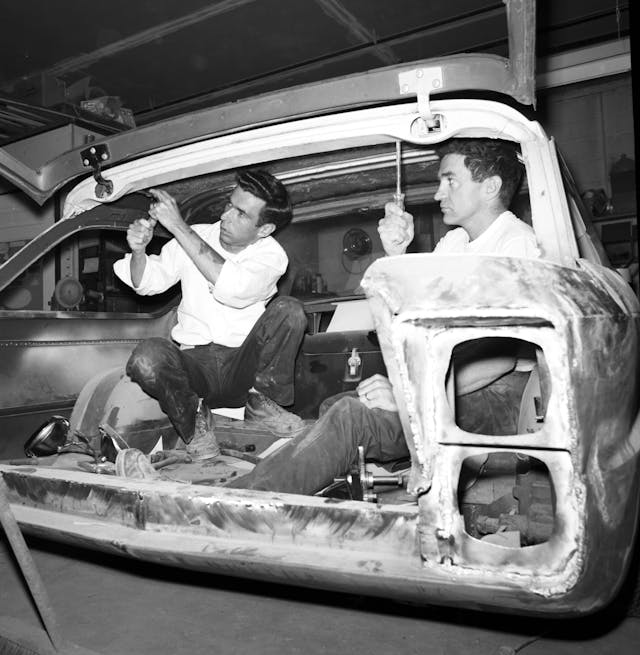
The Deora’s notable features included a radically reshaped cab accessed through a front-mounted, center-hinged door. It was powered by a slant-six engine mounted in the middle, behind the front seats. It incorporated a number of Ford parts: Mustang taillight bezels for side air-ducts, sequential Thunderbird taillights, backlight glass from a Ford sedan, and the rear hatch of a Ford station wagon as a flip-up windshield. According to the Alexanders, the Blue Oval’s rivals at Chrysler headquarters, who eventually sponsored the car, were never the wiser.
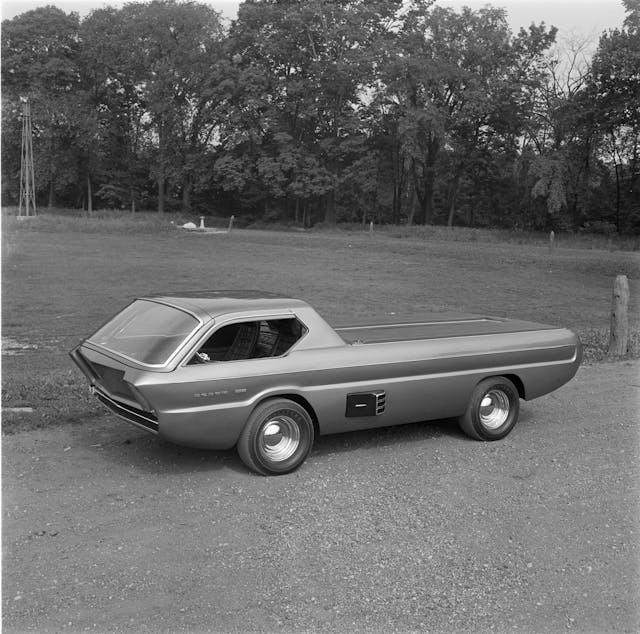
As it turns out, that image up top is not Photoshopped—or even “airbrushed,” as would have been done in the era of chemical film photography. It was a real car.
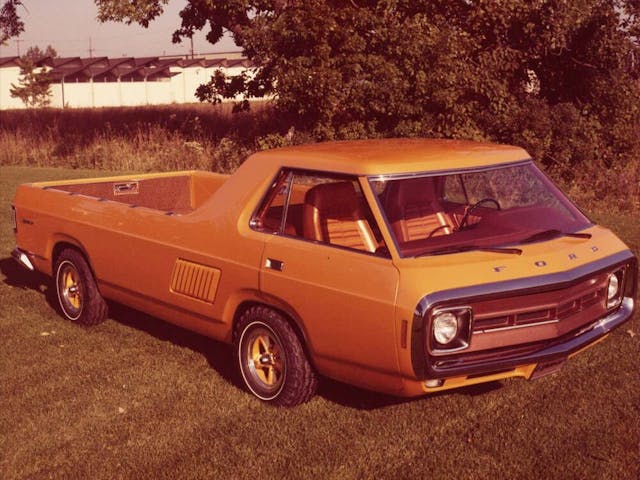
If the folks at Chrysler were unaware of how many Ford components went into the “Dodge” Deora, designers and managers at Ford were probably in on the secret. Just a few years after the Deora made the show car circuit, Ford revealed a concept vehicle at the 1973 Chicago Auto Show. It was called the Explorer, and it very much looked like it was patterned after the Deora.
The name of the concept was not new in the Ford lexicon. Before Explorer meant an SUV, it designated an option package on the F-100, Bronco, and Ranchero trucks. Interestingly, a period press release describes the 1973 Explorer as “a foretaste” of what the full-size “Ford F-100 pickup could become,” not as a potential replacement for the car-based Ranchero utility vehicle. It’s quite possible, therefore, that Ford’s Deora-esque show truck was intended to promote the Explorer option package. Either way, this 1973 concept was the first Ford vehicle known as an Explorer.

The Explorer was probably built from a pickup truck, like its Dodge lookalike: One of the press releases, in describing the Explorer’s mid-engine layout, noted that the engine had been moved from “its normal position in a Ford F-100 pickup.” However, the Explorer’s cab-forward driving position is more like that of the Econoline van, which, like the Dodge A-100 van upon which the Deora was based, places the engine between the front seats. The Econoline, though, was of unibody design, a structure that is more difficult to stretch or shrink than the frame of an F-100.
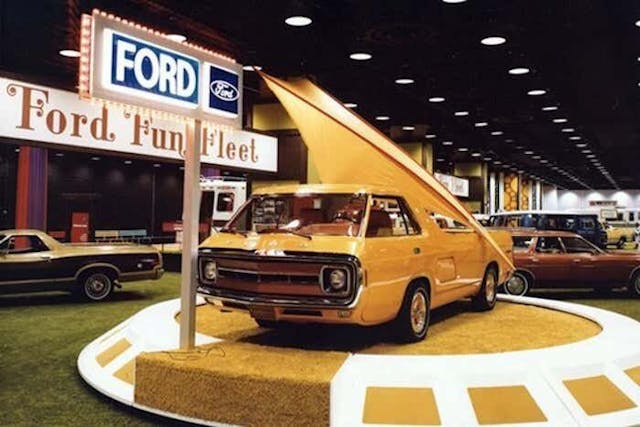
Both the Explorer and the Deora rely on some sort of mid-engine layout, though the Ford’s is more extreme. The Alexanders moved the Deora’s six-cylinder only 15 inches; to create the Explorer, the Ford designers moved the truck’s (or van’s) V-8 back a full five feet.
When it came to speed, the Deora wasn’t much of a hot rod. Chrysler’s venerable slant-six engine probably deserves a plaque in the engine hall of fame, but most folks don’t regard it as a performance powerplant. For the Explorer, Ford chose V-8 power, selecting its 429-cubic-inch big-block in the 375-hp / 450 lb-ft tune of the contemporary Thunderbird. The Explorer and the Deora differed in transmission design, too: The Explorer’s two-pedal interior indicates an automatic gearbox. The Deora had a three-speed manual.
Ironically, though the Deora came from the radical world of custom cars and the Explorer from a relatively staid corporate culture, the Ford was theoretically the higher-performance vehicle. I say theoretically, because I haven’t been able to determine if the ’73 concept was operational or just a show-car pushmobile. If any reader recalls any contemporary coverage clarifying the matter, please let us know in the comments.

Although there’s no indication that Ford ever intended to put the Explorer concept into production (it was still selling the Ranchero ute), the Explorer’s design is more practical than the Deora’s. The latter has no side doors; the windshield flips up and the lower front panel swivels open, allowing the driver and passenger to get in and out via the front of the vehicle, in the style of the Isetta microcar.
The Deora also relied on a complicated linkage to swing the steering wheel out of the way when passengers were entering or exiting, and the steering “wheel” itself is actually a dragster-sourced yoke. In contrast, the Explorer had a more user- (and production-) friendly interior, with conventional driver- and passenger-side doors.
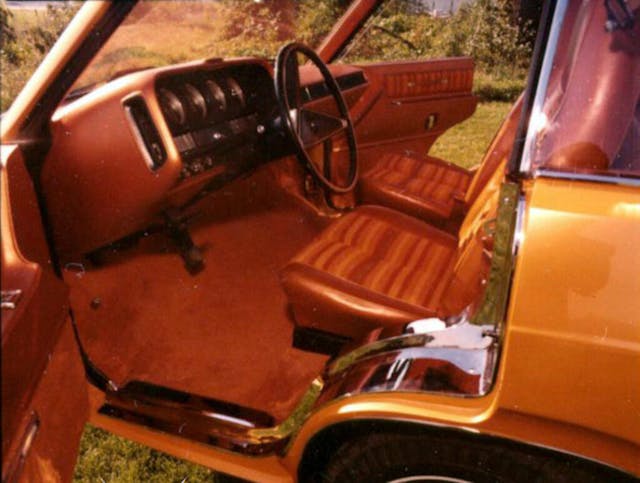
That interior, by the way, indicates how quickly trends changed between 1965 and the early ’70s. The Deora’s cab is upholstered mostly in black vinyl, while the Explorer’s is very, very orange—down to the roots of its shag carpet and the spokes on its Torq Thrust–looking wheels. Even the truck bed is carpeted in orange.
Surprisingly, the Explorer did not have an eight-track tape player, though it did have an AM/FM stereo in the overhead console—with a quad-speaker system aimed, so the PR materials ran, at music buffs.
Perhaps the most striking feature of the Explorer when it was on display in Chicago was its “Parawing” tent, really more of a tarp, that could be stretched over the bed to create a shelter. At over nine feet long and over five feet wide (110.7 x 65 inches), the Explorer’s bed was larger than that of any current F-series Ford.

The Explorer’s bed should have easily accommodated two sleeping bags and related camping gear, but I haven’t been able to find any photos of the bed in use. I suspect that the big-block V-8 might have taken up some of the cargo space. The press materials mention removable engine access panels, so the powerplant may have been located low in the frame.


It would be nice to credit the team responsible for styling the Explorer, but Ford archivists say that fact isn’t recorded. They were, however, able to locate studio photos dated April 29, 1971, of two clay models with 1974 license plates. Apparently, Ford was considering two alternatives as theoretical replacements for the F-100 pickup: a more conventional pickup with a separate bed and a rearward driving position, whose front-end styling may have influenced the 1986 Aerostar minivan; and what appears to be a fully formed version of the cab-forward Explorer concept, wearing a slightly different grille.
Interestingly, that second clay model bore a “Caribou” nameplate. If you zoom in on the first, you’ll see that designers used a truly generic placeholder badge.


There is no indication that Ford ever exhibited the Explorer after its brief display in Chicago and at auto shows and state fairs in 1973. While Ford archivists have graciously provided Hagerty with period publicity materials, they were not able to find any record of what happened to the Explorer concept. Details of its ultimate destiny are not in Ford’s corporate collection, as far as I have been able to determine. Most likely, it was crushed years ago.
The Deora is currently owned by Detroit-area collector Tom Abrams, who operates the Reliable Carriers service used by many to transport their vehicles to shows and to new owners. The 1973 Ford Explorer concept survives in name only.
***
Check out the Hagerty Media homepage so you don’t miss a single story, or better yet, bookmark it. To get our best stories delivered right to your inbox, subscribe to our newsletters.



I could sit and surf the web for hours and days and not come across all of the interesting automotive stuff that the staff at Hagerty puts out for me to read and view. I knew a lot about the Deora, but this Ford is something I never even suspected existed. Thanks for this article, Ronnie! 👍
I agree. This was very interesting and enjoyable.